 Marketers in the life-sciences field are facing ever-evolving challenges to meet ever-changing patient expectations. According to one recent study, 77% of patients start their health journey online beginning at a search engine. This action alone provides marketers huge opportunities as well as challenges to connect with patients or caregivers at the very start of the engagement cycle. As a result, marketers are starting to incorporate digital and social aspects while also embedding personalization throughout the communications, especially in more traditional channels, such as television.
Marketers in the life-sciences field are facing ever-evolving challenges to meet ever-changing patient expectations. According to one recent study, 77% of patients start their health journey online beginning at a search engine. This action alone provides marketers huge opportunities as well as challenges to connect with patients or caregivers at the very start of the engagement cycle. As a result, marketers are starting to incorporate digital and social aspects while also embedding personalization throughout the communications, especially in more traditional channels, such as television.
The torrent of big data allows this, but it doesn’t mean it’s easy. Marketers must meticulously measure and analyze relevant data in order to create impactful efforts for the new-age patient and physician. By developing customer-service programs, strategies to appeal to millennials, prioritizing mobile, and personalizing both patient and physician interactions, marketers can set themselves and the brands they represent up for success. C-suite executives from a diverse field of agencies have provided their input on the challenges, changes, and opportunities that lie ahead for tomorrow’s marketing experts.
The biggest challenges facing pharma marketers in the next five to 10 years…
 Didi Discar
Didi Discar
Principal, Carling Communications
Two very different challenges will need to be addressed by healthcare marketers in the future. As consumers access the more than 165,000 health apps available to generate real-time data on the status of their health, marketers will want to harvest these data for personalized solutions. The question is how can we identify these data and use the information ethically, legally, and efficiently? Innovations that are seen in other areas need to be applied to the healthcare industry.
The second challenge is the current political climate and how it will impact the future of healthcare. As an industry, we need to be prepared to counteract public attacks and political outrage in the face of drug pricing and supply decisions.
When we can harness data from diverse sources — electronic records and mobile health apps — and combine that information with prescription data and claims data we’ll be able to move away from conjecture and really understand the physician mindset. When we can connect the dots, and see how clinical markers lead to prescription-writing behaviors, when we can uncover information that leads to better patient adherence, when we can harvest EHR and in-home health data, we will be able to develop better-targeted messages.
Kim Johnson
President, Palio, an INC Research/inVentiv Health communications agency
We are all paying close to attention to Washington, D.C., for many reasons, including the potential drug price caps under evaluation. Decreased prices and profits will surely trickle down to promotional spending. Markets are only increasing in competition and costs for drug discovery are not decreasing. This pressure will result in an ongoing focus on accountable marketing practices, where marketers can show clear return on new investments and target spending toward the highest-impact opportunities.
Advances in technology and shifts in regulations will allow for broad data exchange outside the prototypical clinical program in an effort to safely accelerate speed to market of life-saving products. Expansive data and insights will increase in importance for effective and efficient commercialization methods.
 Ed Mitzen
Ed Mitzen
Founder, Fingerpaint
The biggest challenge facing healthcare marketers will be the diminished need for breakthrough disease treatments. If we look at where we are today, HIV is now a chronic treatable condition. Hepatitis C is being eradicated. Cholesterol and high blood pressure are relatively controlled. And while there are extremely prevalent diseases such as asthma and diabetes that are yet to be 100% controlled, we are getting far closer to making these ailments a distant memory. This trend is sure to be accelerated by personalized medicine, using the human genome and big data engines. That leaves us with cancer, Alzheimer’s, ALS, and a few other diseases that will require truly innovative healthcare marketing techniques with the advent of new therapies and treatments. Big data tied to outcomes will drive prescription decisions, further diminishing the need for smart healthcare marketing. As marketers, we must continue to find ways to add value in the system, bridging the gap between technology solutions/wearables, outcomes data, and patient education.
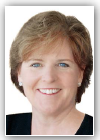 Lynn O’Connor Vos
Lynn O’Connor Vos
CEO, ghg, Grey Health
I think there is both a challenge and an opportunity with millennials and Gen X, the new health customers. They are inquisitive and tech savvy. They want answers, and they’re impatient. They expect to get the same kind of service in health that they get from every other sector. Our own study has found that millennials specifically don’t care about having a primary care physician or a primary care dentist, and they are very comfortable going to urgent care centers such as CityMD and retail clinics such as Walgreens and CVS. In fact, they’re extremely interested in getting anything they can out of retail health. The report also says Gen Xers would love to get their eyes examined, their teeth checked, and their medical advice at a retail location. What this means is that customer service has come to healthcare. We have to address this in a much bigger way than we did five years ago.
The new health opportunity is to evolve a model that actually works for this new health customer. I think the media companies — Facebook, Google, Apple — are in a very powerful position within the health ecosystem to create a model that actually works for the new health customer. First, because that is where the customers are. Right now there are 70 million people on Facebook, and many of them are talking health. For oncology alone, there are 250,000 Facebook groups. Facebook isn’t all; one in 20 Google searches are on health.
Another vital role of the new media is in providing an enormous amount of behavioral data about how people search and what they’re searching for. For example, Google is exploring how to predict whether someone has a disease based on the symptoms being searched. Then if we add machine learning into the formula, there’s a whole industry that’s developing outside of the traditional pharmaceutical industry. The challenge will be for the pharmaceutical industry to embrace technology and the new health media in a much bigger way, so that we can address the needs of the health customer and also potentially help them to stay healthier.
 Dave Paragamian
Dave Paragamian
Managing Director, Razorfish Health
The industry is in a hypercompetitive era — whether you’re a marketer on the company side or the agency side. In the past, we have addressed the competitive landscape by working with algorithms. There has been a traditional formula in terms of how to commercialize and launch a new product or how to commercialize and introduce a new indication. We need to break out of being algorithm cookbook-based marketers, and do things in a completely different way.
“I’m speaking to 8,000 primary care physicians or 18,000 primary care physicians," doesn’t work anymore. We need to personalize the message and make sure it is relevant. Whether it’s delivered by a representative, a medical science liaison, in a nonpersonal way on a laptop, on a desktop, on a mobile phone, or in a convention panel, the message needs to feel personalized. Another key headline is Analytics 2.0 in terms of leveraging data, so that we’re not just drowning in it. We have plenty of data but we need to leverage the analytics so that we really have insights that are actionable and that change the way we deploy our resources, the way we deploy our talent, or the way we speak in a customized individual way to our target audiences.
There are still plenty of folks who are still trying to cook by their recipe algorithms and they’re going to get left behind. However, we see our clients willing to entertain new ideas, such as an online community of physicians or other ways to deliver a message over a standard sales aid.
Changes are on the horizon; what will the marketing toolbox of the future look like?
 Kim Johnson
Kim Johnson
President, Palio, an INC Research/inVentiv Health communications agency
Customer decision-marketing across the healthcare spectrum continues to shift from individuals to organizations and healthcare systems. New approaches will come to the forefront because of limited access and increased reliance on EMR systems for information. We will likely see an increasing desire for on-demand virtual consultation, which should present opportunities to explore more innovative marketing channels and services. Additionally, video and remote doctor consultations are on the rise, which may increase the use of virtual reality and chatbots in pharma marketing.
I expect we will see increased use of video content in the future, At Palio, we have seen a 25% increase year over year in video production for our clients. Video has grown to become a preferred educational format and increasingly efficient to produce and port through many engagement channels.
I predict the mix of investments in global congress presence and other traditional sales channels will shift as live events will be supplemented with more virtual experiences moving forward.
Forrest King
Founding Partner,
Juice Pharma Worldwide
Brands will change as the mass-market strategy adopts the rare disease or specialty marketing strategy. This means high-touch, highly sensitive, and responsive messaging and services. Trust is the most important asset in small communities and as these marketing methods catch on, more marketers will experience them and propagate them into more brands. This will bring about the sea change in thinking about marketing a pharmaceutical brand as a community member rather than as an outsider who appears to be driven by profit or self-interest. The tools that will make this possible are the combination of big data, AI, and the ultimate 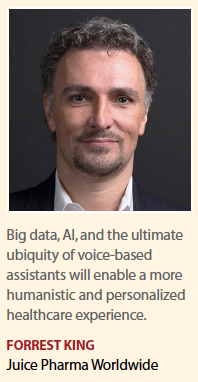 ubiquity of voice-based assistants.
ubiquity of voice-based assistants.
These three tools ironically will enable a more humanistic and personalized experience, allowing all customers to have a more rewarding and less confusing experience with the pharmaceutical company and the brand.
We are in the midst of a marketing revolution that we uncomfortably refer to as multichannel marketing, because we have no better phrase to capture the complexity of the modern pharma marketing formula: channel x stakeholders x customer advocates x payers x media x government = marketing. The three tools mentioned above will dictate that marketing plans evolve.
Today, brand plans are built on the age-old backbone of product positioning, branding, the single campaign idea, and product messaging.
We will see this changing as pharmaceutical brand marketing develops the tools to become more focused on people.
Also, we should pay close attention to rare-disease brand marketing to see into the future.
Steven Michaelson
Founder and CEO,
Calcium USA
The future is here. The significant change in pharma marketing methods, as with virtually any product today, is allocating and finding the most effective and efficient vehicles to motivate individual customers to act, regardless if they are HCPs, patients, or consumers. Simply stated: how do marketers navigate the marketing/media/channel mix? Even though big marketing budgets are always better, big budgets can seduce marketers to lose focus. Diluting the message across too large of a diverse communications mix can threaten your key marketing objectives. Staying focused on a selected marketing medium — no matter how large or small — and adhering to it is paramount.
There are recent examples of short-term brilliance but long-term failure. “Flavor of the month" tactics that seem too good to be true 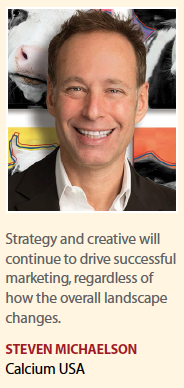 usually are, for example, incredible insurance rebates for patients… here today, gone tomorrow.
usually are, for example, incredible insurance rebates for patients… here today, gone tomorrow.
One tactic that will wane in importance in the not-too-distant future is the digital banner ad. The oversaturation of banner ads, the phenomenon of “banner blindness," and advancements in so-called native advertising will push the banner ad out of the digital channel marketing mix in favor of more engaging digital content.
Although we have a pretty good idea of what tactics will not be effective in the future, we can certainly predict that the drivers of all tactics — today or tomorrow — are still the most valuable tool in marketing: strategy and creative. These will continue to drive successful marketing, regardless of how the overall landscape changes.
Carolyn Morgan
President, precisioneffect
TV will remain, but we’ll see it shift to better targeted and more meaningful distribution, so every impression actually counts.
What’s likely to disappear? Every one of our clients is questioning tradeshows and their value. It is considered heresy to not go, so they continue to go despite the perceived lack of benefit. It is an expensive endeavor, yet with physicians being harder to call upon than ever it puts them in a Catch-22. Virtual roadshows may be a worthy consideration to augment and even replace tradeshows, offering HCPs a more customized and educational experience.
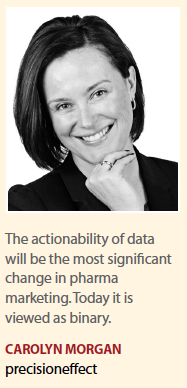 The action-ability of data will be the most significant change in pharma marketing. Today it is viewed as binary. Where opportunity lies is plotting that data to not only understand where our audiences disengage with the brand, but why. When we aggregate the why and translate it into behavioral biases we will find insights we can leverage, and that is where we can win as marketers. Using this information, we can build customized experiences that unstick our audiences and motivate them to action — think Stitch Fix and Plated but for healthcare.
The action-ability of data will be the most significant change in pharma marketing. Today it is viewed as binary. Where opportunity lies is plotting that data to not only understand where our audiences disengage with the brand, but why. When we aggregate the why and translate it into behavioral biases we will find insights we can leverage, and that is where we can win as marketers. Using this information, we can build customized experiences that unstick our audiences and motivate them to action — think Stitch Fix and Plated but for healthcare.
Michael Parisi
Managing Partner, Ogilvy CommonHealth Worldwide, a WPP Health & Wellness company
There is an incredible amount of new technology and information that allows us to segment and target audiences even better, whether it’s HCP, consumer, or patient by topic relevance, by diagnosis, or by preexisting conditions. This enables us to get really smart with the content that we deliver, so it’s both contextually accurate and contextually relevant for that moment in time and that’s really exciting. It’s no different from intuitive purchases. If you go on Zappos and you buy something you will receive future directions to other items that fall within your “like" selection; this type of lifetime serving of content at the appropriate points of time is going to continue to grow and add value to so many people in need of valuable information.
The traditional website model has been — whether it’s a brand.com website or a company website — that the user would click on information and most likely would get the patient version of the prescribing information. But if there is a chatbot, we can start a conversation. Image if the chatbot says something like “What type of information are you looking for?" and you can type in: “I would like to know how this product works." The user would then be presented with the MOA story, and then once this is read through, the little chatbot would say: “Most people who read this also want to know how effective the product is, would you like to learn more?" Hopefully, the user answers “Yes."
And now we’ve started an engagement based on what the user is looking for. This is exciting because as marketers and as agencies, brand story and content are critically important. Generating content means listening to the needs of your audience to understand what they need so you can develop and evolve the content based on those needs. This is an exciting way to be even more involved in our client’s business and brands, because we’re living the brand every day.
Frank Powers
Managing Partner, Elevate Health
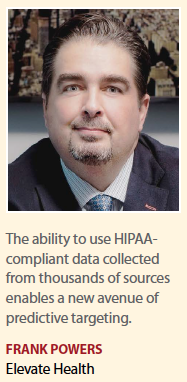 The development of personalized marketing will change everything. It’s already happening in consumer marketing based on the ability to collect thousands of data points on searching/buying habits. While in its infancy in DTC marketing in healthcare, the recent ability to use HIPAA-compliant data collected from thousands of sources to analyze healthcare needs and decision-making enables a whole new avenue of predictive targeting on an individual basis.
The development of personalized marketing will change everything. It’s already happening in consumer marketing based on the ability to collect thousands of data points on searching/buying habits. While in its infancy in DTC marketing in healthcare, the recent ability to use HIPAA-compliant data collected from thousands of sources to analyze healthcare needs and decision-making enables a whole new avenue of predictive targeting on an individual basis.
We’re already working with our data analytic partners to find ways to apply this to professional marketing, overlaying traditional prescribing data with new personalized data on patients and physicians to create a hybrid of personalized marketing that is regulatory compliant.
Mobile marketing tactics, especially those that incorporate video, will continue to proliferate in DTC and DTP. As more and more new apps are developed for healthcare providers to perform clinical tasks and gather information, we’ll find more effective ways to communicate through that channel.
One technique we think will eventually disappear is the building of personas to target. With real data available to build target profiles directly, the need to theorize and build generalized personas will fade away. One tactic everyone predicted was dead was the printed sales aid, but we are getting more and more requests to have a printed piece for rep use. The sophisticated digital sales aids are great, but rarely get used to their full potential due to restrictions on both access and time for interactions, still allowing a place for print collateral to be leveraged.
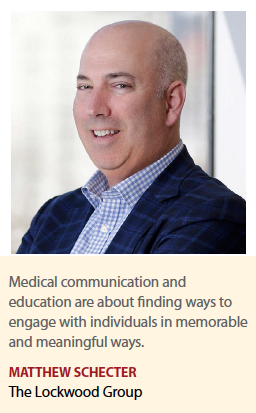 Matthew Schecter
Matthew Schecter
President, The Lockwood Group
With an increasing number of treatment options, targeted therapies, complex dosing regimens and complicated, ever-changing guidelines, medical communication and education are more important than ever. But who has the time? This is the challenge that we are facing today in medical communications and this trend will continue into the next five years and beyond, necessitating a shift in communication modalities.
Traditionally, medical education was a long form, one-size-fits-most messaging. This model has been changing and will continue to evolve.
Content is becoming more tailored and modular allowing for targeting across the continuum of care to provide the right message to the right target at the right time.
Modular content also lends itself to new mechanisms for dissemination, alongside traditional channels. Dinner meetings and teleconferences remain a staple for learners who value the personal interaction and opportunity to engage in live discussion.
Virtual platforms and mobile focused initiatives bring content into the HCP’s hands to absorb the content on their own schedules. For those who crave something new and different, there is a groundswell of interest and investment in the virtual and augmented reality space, which will increasingly become a valuable channel for bringing educational content to life. Watching an MOA in 3D or interfacing with a simulated patient creates a more personal and memorable interaction, transforming attendees into actual participants in the educational experience.
Segmentation and targeting will also become increasingly critical in order to tailor content by specialty, focus, and general interest. Knowing who each customer is allows for curation of content and channel that will provide the greatest value for each individual medical communication and education is about finding ways to engage with individuals in memorable and meaningful ways. The creation of stellar content, coupled with a spectrum of delivery platforms will continue to improve the ways in which we can maximize the impact of each connection.
Reaching patients and physicians in the future will mean…
Matt McNally
President, Digitas Health
What will never change is that moment between the patient and his or her healthcare professional. Everything else will evolve. I don’t think television will go away. I think the industry is going to take a much more digital and data approach to television, and broadcast television in the future will look very different than it does today.
Digital will continue to evolve and play a key part to the healthcare journey. Agencies are also taking a more data-driven approach to print. I think we’re going to use many of the same levers, but how we engage with them, how we buy them, how we deploy them, will look different with data and technology advances driving that evolution.
Social and mobile are gaining traction very quickly in nonpersonal promotion, specifically among professionals, and around peer-to-peer interactions happening in the millennial physician audience. I believe we will see a level set across specialties. Historically, there have been certain specialties that indexed very high against journal advertising and some that were more digital-savvy. Now, everyone’s growing up with technology, and digital will play a big role in how we use those mechanisms in the next 12 to 24 months.
As digital and mobile continue to play a bigger factor with in-office engagements, there is an evolution taking place from a paper-based engagement at point-of-care to a digital engagement with point-of-care driving lots of benefits for clients. One, there is the ability for more precision targeting in terms of HCP offices and areas for engagement with different stakeholders. And two, there is trackability. It was hard to track the impact of a take-one brochure or a poster. Now, we’re deploying a lot of in-office activity through mobile devices, tablets, and iPads — all of which is trackable.
Ed Mitzen
Founder, Fingerpaint
Maybe we shouldn’t assume that physicians are still in a position to make prescribing decisions in five years. As big data/IBM Watson/analytics continue to drive prescription-predicted outcomes, physician choice will become far less relevant. The primary pathway to reach physicians will follow the same one to reach consumers. The social media channel or search engine of choice in five years will by default be the most effective way to reach physicians.
As patient care evolves in the United States, many more people will visit primary care physicians in nontraditional locations, such as Walgreens, CVS, and 24-hour urgent care facilities. With the advent of 3D printing of medications, the entire supply chain may be turned upside down, which could give even greater power to the pharmacy chains by producing medications on demand.
Marketers will need to continue to adapt to the ever-changing landscape and industry’s latest influencers.
The need to partner with pharmacy locations, as an example, will become much more important than it is today.
And only those preferred pharmaceutical companies and their products will be permitted to “market" within these new channels, so influence will continue to be diminished without preferred formulary status.
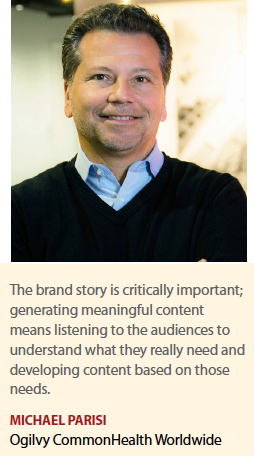 Michael Parisi
Michael Parisi
Managing Partner, Ogilvy CommonHealth Worldwide, a WPP Health & Wellness company
The importance of patient groups and patient advocacy organizations is going to continue to elevate because they understand the needs of individuals and the communities within specific categories.
Applying technology is great, but we have to understand the customer journey or the patient journey so the technology is applied the right away to truly make a difference. Voice-activated technology such as Alexa is really exciting if we can take that technology and make the day-to-day life of someone who’s living with an illness or debilitating disease a bit easier.
Technology should add value. The problem is as an industry we’ve been slow to move and by the time we are ready, the technology is often outdated. If the consumer model of how to buy groceries, for example with Amazon and Whole Foods coming together, outpaces healthcare, we’re losing as an industry.
We should be leading the technology charge.
Robin Shapiro
Global President, TBWA/Worldhealth
I envision a day when the experience of interfacing with a pharma brand is not that different from interfacing with the best consumer brands. Think about how it feels to experience Apple, Mercedes Benz, or Airbnb — it’s an incredible experience. I go 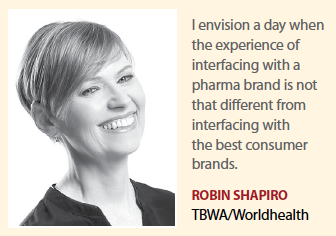 online to buy a car, it’s fun to play around, and design the car of my dreams. The technology and user experience converge for an unforgettable experience. When we compare that experience with one of visiting a typical pharma site, we just went back 10 years in time — the experience is not user-friendly.
online to buy a car, it’s fun to play around, and design the car of my dreams. The technology and user experience converge for an unforgettable experience. When we compare that experience with one of visiting a typical pharma site, we just went back 10 years in time — the experience is not user-friendly.
Brands should be intuitive, serving the needs of the person, and fitting cohesively into his or her life. You want to be able to open up your iPhone and have it connected to all your needs, including medical. Medicine isn’t a whole separate category; it should fit into your life. Pharma companies with their resources should be able to create a valuable experience for patients — an experience that goes beyond the pill. It’s about making healthcare and medicine fit into a person’s life and creating a more rewarding experience. We’re going to take the pain out of the system. (PV)
~~~~~~~~~~~~~~~~~~~~~~~~~
Media as Part of the Equation
A discussion around the future of pharmaceutical marketing or advertising wouldn’t be complete without input around media development, which is central to the delivery and engagement with patients and healthcare professionals.
“Media agencies are at the center of the evolution of marketing platforms, data targeting, search engines, voice searches and queries," says Jedd Davis, managing director, Publicis Health Media. “Media companies consider these factors daily. And when we talk about developing dynamic creative, this is something that we are involved with. We need to understand who engages with the technology, work with the data we have, and then understand how to optimize those insights, and retarget different messaging. As a 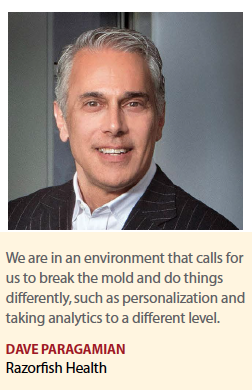 media company, we’re part technologist and we’re part creative. To meet the need for a lot of different content, we’re going to get content from publishers, in addition to creative agencies, and offer it up to patients and HCPs across all of the new marketing technologies."
media company, we’re part technologist and we’re part creative. To meet the need for a lot of different content, we’re going to get content from publishers, in addition to creative agencies, and offer it up to patients and HCPs across all of the new marketing technologies."
Dr. Susan Dorfman, chief commercial officer, CMI/Compas, says within the patient and HCP community there will be continued growth of digital and mobile in reaching both, and the industry may even start to see mobile in print evolve as a new innovation with particular interest coming from younger generations.
“Mobile in print allows print to take on a digital component and has all the features of digital such as video etc., with a mobile chip planted in the print piece," she explains. “I also believe in voice as a channel and bots — leveraging artificial intelligence — as having vast utility over time, although I believe our industry will be later adopters. In the beginning we’ll be able to use them to help supplement customer service, but in the future we can expand chatbot technology to help with a higher level of problem-solving well beyond individual engagement, messaging, and targeting."
Dr. Dorfman predicts that telehealth settings and virtual point-of-care will significantly evolve in the next five years and be an incredible place to connect patients and HCPs at the point of action — before, during and after care — to deliver information, value, reminders, and anything else that will support their healthcare and adherence needs and interactions with healthcare providers over time.










